Cormorants and shags, names often used interchangeably, can be distinguished more by geographical preference than species. The presence of a crest, however, often tips the scales towards the term “shag.” Taxonomically, the Cormorant Family’s genera are debated, but this overview simplifies it to Microcarbo for smaller cormorants and Phalacrocorax for the majority. The blue-eyed shags, a distinct group, are sometimes categorized under the genus Leucocarbo.
All members of the cormorant family are adept underwater hunters, primarily for fish. This aquatic lifestyle has shaped their evolution, resulting in specific physical traits. Webbed feet are a fundamental adaptation for efficient swimming, a feature shared with ducks. However, unlike many buoyant ducks that struggle to submerge fully, cormorants have evolved dense bodies, achieving near-neutral buoyancy underwater. This density minimizes energy expenditure in combating buoyancy during dives. Their feathers, unlike the highly water-repellent plumage of ducks, produce less oil, reducing air retention and further aiding submersion. This characteristic leads to the iconic pose of cormorants standing with outstretched wings, sun-facing, to dry their feathers – a common sight, unlike the adage “like water off a cormorant.”
This underwater efficiency comes at an aerodynamic cost. Cormorants face greater challenges in flight compared to many other birds, particularly during takeoff. To initiate flight, they typically run along the water’s surface using their webbed feet as paddles while vigorously beating their wings. Initial flight paths are often low to the water, leveraging ground effect to gain lift from the reflected air pressure beneath their wings.
While graceful swimmers, cormorants are notably clumsy on land. Their feet, optimized for aquatic propulsion, are ill-suited for terrestrial locomotion. Consequently, they minimize walking. Consider when you last observed a cormorant walking – it’s a testament to their aquatic specialization.
Cormorants are pursuit predators, chasing their prey at high speeds underwater. Some species strategically hunt near the seabed to limit escape routes for their meals. Their diet is diverse, extending beyond fish to include worms, eels, mollusks, crustaceans, and even octopus.
Distinguishing a cormorant from an anhinga can be tricky. Anhingas share similar appearances and behaviors but belong to their own family, Anhingidae, with the single genus Anhinga and four species. Key differentiators include anhingas’ wider tails and thinner, more pointed bills compared to cormorants.
For a broader understanding of cormorants, Raeesah Chandlay’s “Cormorants – The Master Divers” on avibirds.com offers further insights.
Genera and Species within the Cormorant Family
Let’s explore the fascinating diversity within the cormorant family, examining different genera and species:
1. Genus Microcarbo: The Smaller Cormorants
These are the smallest members of the cormorant family, distributed across Europe, Asia, Africa, and Australasia.
1.1. Reed Cormorant, Microcarbo africanus
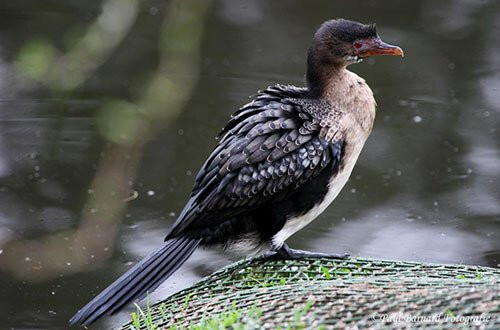 Reed Cormorant
Reed Cormorant
Description: The Reed Cormorant, also known as the Long-tailed Cormorant due to its proportionally long tail, is characterized by black legs and a yellow bill. The bill base and lores exhibit red or yellow skin. During breeding season, adults sport glossy black plumage and a short crest, while non-breeding plumage features blackish-brown upperparts and whitish underparts. Southern subspecies may retain their head crest year-round.
Range: Sub-Saharan Africa.
Habitat: This cormorant prefers freshwater environments such as ponds, rivers, and marshes, as well as sheltered coastal areas. It typically hunts in shallow water but is capable of deep dives.
Diet: The Reed Cormorant’s diet consists primarily of slow-moving fish, supplemented by frogs, aquatic invertebrates, and small birds.
Conservation status: Least Concern.
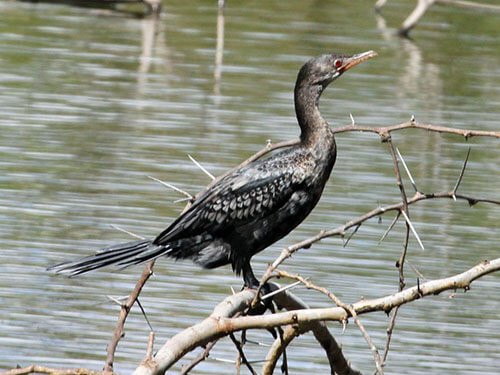 Reed Cormorant closeup
Reed Cormorant closeup
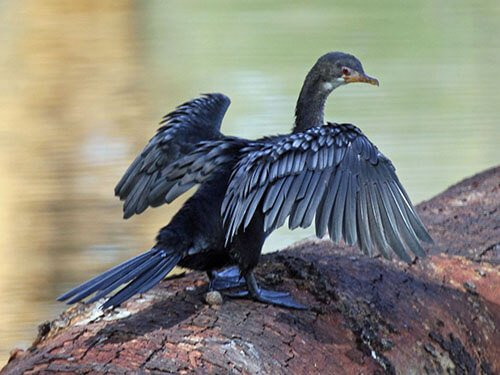 Reed Cormorant feathering
Reed Cormorant feathering
1.2. Crowned Cormorant, Microcarbo coronatus
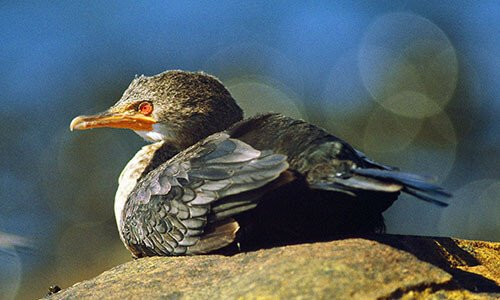 Crowned Cormorant
Crowned Cormorant
Description: The Crowned Cormorant is distinguished by a small crest at the front of its crown. Adults have all-black plumage, striking red eyes, and red facial skin around the lores. Juveniles exhibit dark brown upperparts, paler brown underparts, and lack the crest. The red eyes are unique among small African cormorants. Previously considered the same species as the Reed Cormorant, it is now recognized as distinct, partly due to its shorter tail.
Range: Southwest Africa, ranging from Angola to southwest South Africa.
Habitat: Primarily marine, the Crowned Cormorant stays close to the coast, rarely venturing more than 100 meters inland except to roost or breed. They generally remain within 10 km of the shoreline. While the population appears stable, estimates suggest fewer than 10,000 individuals.
Diet: Their diet includes fish and small crustaceans.
Conservation status: Near Threatened.
 Crowned Cormorant closeup
Crowned Cormorant closeup
1.3. Little Pied Cormorant, Microcarbo melanoleucos
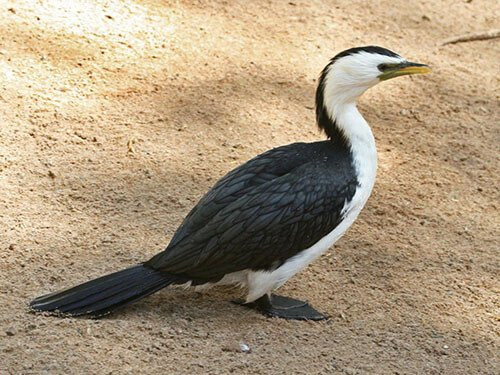 Little Pied Cormorant
Little Pied Cormorant
Description: The Little Pied Cormorant, also known as the Little Shag, is easily identified by its contrasting black upperparts and white underparts. It features dark lores, a short yellow bill, and black feet. In New Zealand, some individuals exhibit mostly black underparts with a white throat.
Range: Australia, New Guinea, and New Zealand.
Habitat: This species inhabits a variety of aquatic environments, including swamps, lakes, lagoons, estuaries, and coastal areas.
Diet: The Little Pied Cormorant primarily feeds on fish and crustaceans, but also consumes eels and insect larvae.
Conservation status: Least Concern.
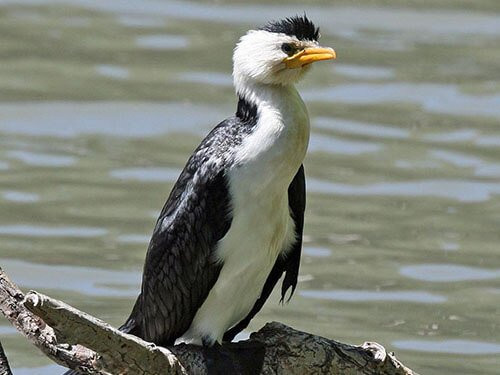 Little Pied Cormorant closeup
Little Pied Cormorant closeup
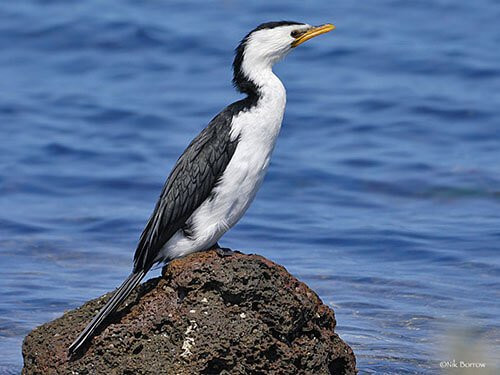 Little Pied Cormorant habitat
Little Pied Cormorant habitat
1.4. Little Cormorant, Microcarbo niger
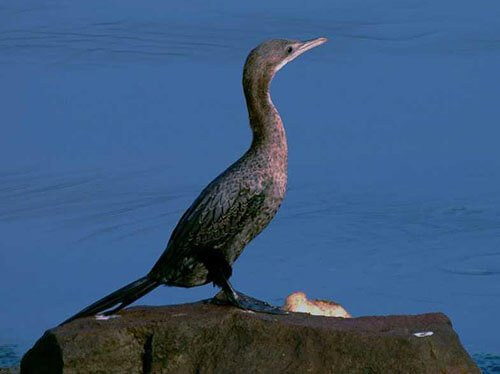 Little Cormorant
Little Cormorant
Description: The Little Cormorant is slightly smaller than the Indian Cormorant and has a shorter bill. The Indian Cormorant, in comparison, has a more peaked head. Little Cormorants exhibit black plumage, black feet, and black eyes. Non-breeding plumage has a brownish tinge and often a white throat patch. During breeding season, some white facial spots may appear.
Range: Indian Subcontinent and eastward to Java.
Habitat: This species prefers freshwater habitats such as small ponds, large lakes, and streams, occasionally venturing into coastal estuaries.
Diet: The Little Cormorant’s diet mainly consists of fish, and potentially sea urchins.
Conservation status: Least Concern.
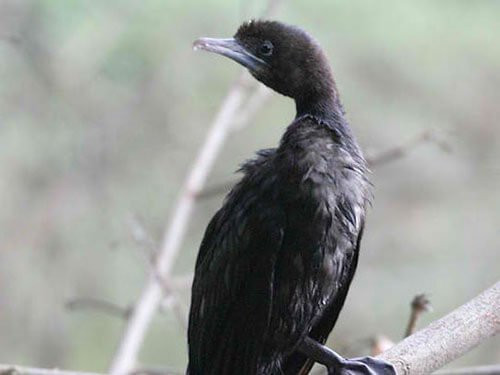 Little Cormorant closeup
Little Cormorant closeup
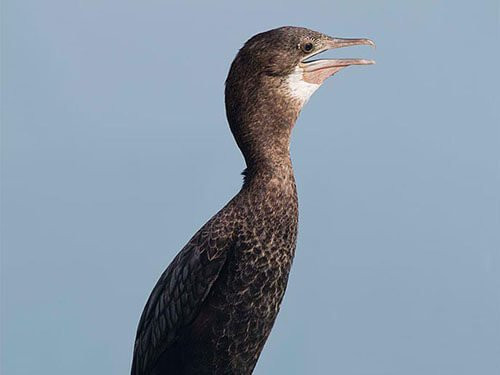 Little Cormorant habitat
Little Cormorant habitat
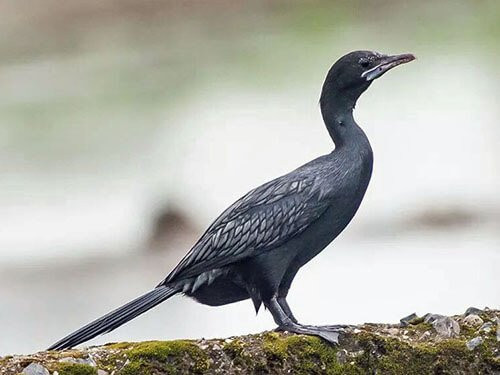 Little Cormorant feathering
Little Cormorant feathering
1.5. Pygmy Cormorant, Microcarbo pygmaeus
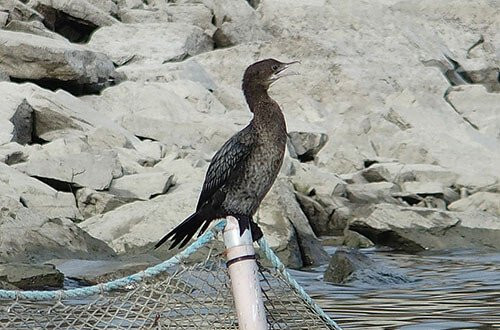 Pygmy Cormorant
Pygmy Cormorant
Description: The nonbreeding Pygmy Cormorant displays brown plumage, darker on the back, and a pale greyish bill. In breeding season, it transitions to black plumage, a black bill, and develops a short, erectile crest. It closely resembles the Little Cormorant, but the crest is often more pronounced in the Pygmy Cormorant.
Range: Southern Europe and southwest Asia, with approximately three-quarters of the population residing in Europe.
Habitat: Pygmy Cormorants favor water bodies with vegetation, particularly rice fields. Estuaries become important habitats during winter.
Diet: Their primary diet is fish.
Conservation status: Least Concern.
 Pygmy Cormorant closeup
Pygmy Cormorant closeup
 Pygmy Cormorant habitat
Pygmy Cormorant habitat
2. Genus Phalacrocorax: The Larger Cormorants and Shags
This genus encompasses a wide variety of cormorants, including the “blue-eyed shags,” named for their distinctive eye-rings rather than eye color. This group includes species like the Antarctic Shag, Imperial Shag, and others, sometimes grouped under the genus Leucocarbo. It’s important to note that “shag” and “cormorant” are often used interchangeably within this genus.
2.1. White-Bellied Shag, Phalacrocorax albiventer
The White-bellied Shag is often considered a subspecies of the Imperial Shag, in which case its scientific name is Phalacrocorax atriceps albiventer.
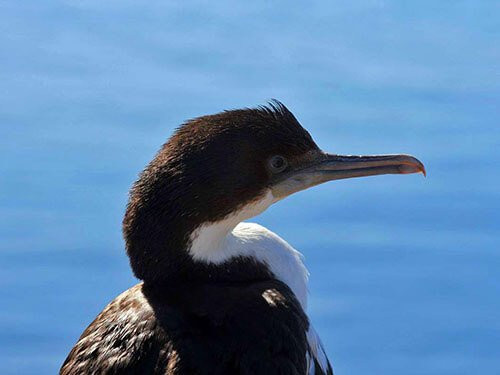 White-Bellied Shag
White-Bellied Shag
Description: As its name suggests, the White-bellied Shag has black upperparts and striking white underparts. Being exclusive to the Falkland Islands, this color pattern readily identifies this cormorant.
Range: Falkland Islands.
Habitat: Primarily found in rocky coastal regions.
Diet: Their diet consists of fish, crustaceans, and octopus.
Conservation status: Least Concern.
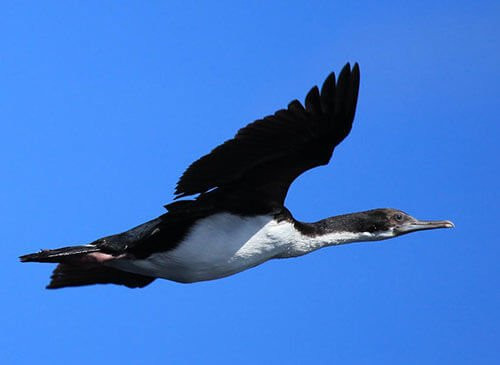 White-Bellied Shag in flight flying
White-Bellied Shag in flight flying
2.2. European Shag, Phalacrocorax aristotelis
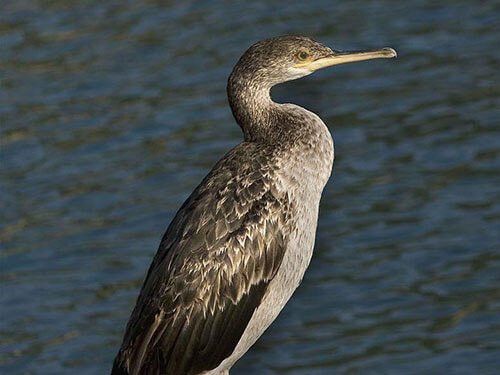 European Shag
European Shag
Description: The European Shag, also known as the Common Shag, is a medium-sized cormorant with black plumage and a yellow gape. It has a long, thin tail. During the breeding season, its plumage develops a greenish sheen. It is smaller than the Great Cormorant and has a thinner bill.
Range: Iceland, Europe (coastal Scandinavia to the Mediterranean), southeast corner of Asia, and northwest Africa.
Habitat: Primarily coastal, rarely found inland.
Diet: Their diet includes fish and eels.
Conservation status: Least Concern.
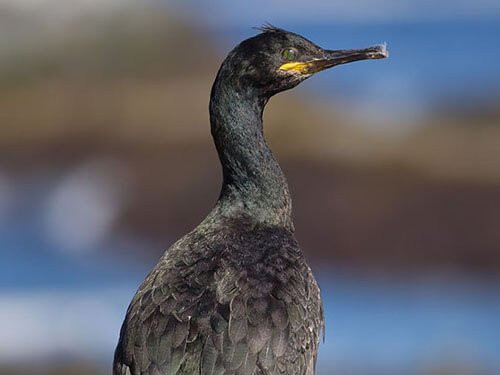 European Shag closeup
European Shag closeup
 European Shag habitat
European Shag habitat
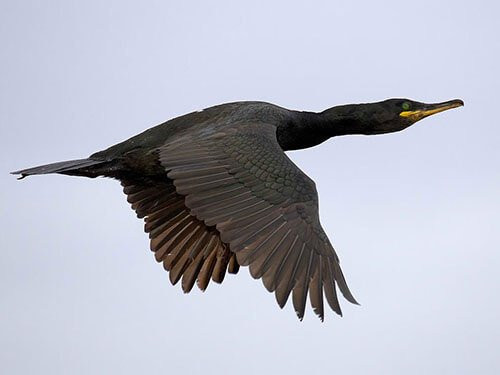 European Shag in flight
European Shag in flight
2.3. Imperial Cormorant, Phalacrocorax atriceps
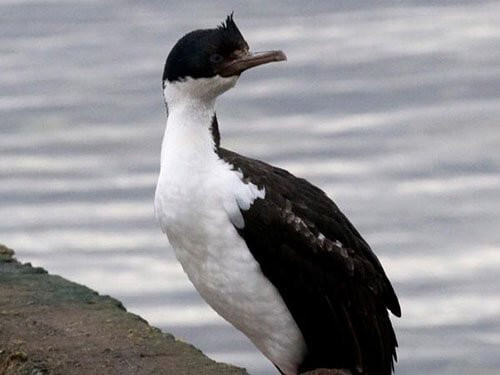 Imperial Cormorant
Imperial Cormorant
Description: The Imperial Cormorant, a “blue-eyed shag,” is characterized by its blue eye-rings. It has black upperparts, including the nape, and white underparts, including the foreneck. Distinguishing features include an orange-yellow nasal knob, pinkish legs and feet, and a black erectile crest during breeding season. The Rock Shag is similar but has an entirely black neck. However, differentiating between blue-eyed shag species can be challenging, often relying on location, which may not always be reliable.
Range: Southern Argentina and Chile.
Habitat: Primarily rocky coastal regions, but also large inland lakes.
Diet: Their diet consists of fish, crustaceans, octopus, and worms.
Conservation status: Least Concern.
 Imperial Cormorant closeup
Imperial Cormorant closeup
 Imperial Cormorant in flight
Imperial Cormorant in flight
2.4. Double-Crested Cormorant, Phalacrocorax auritus
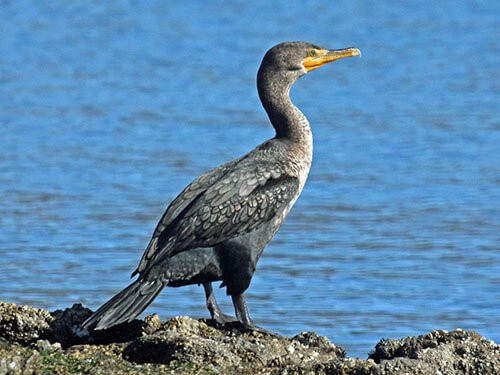 Double-Crested Cormorant
Double-Crested Cormorant
Description: The Double-crested Cormorant is the most abundant and widespread of the six North American cormorant species. It has black plumage and a bare patch of orange-yellow facial skin. A small black-and-white crest appears during the breeding season. Juveniles have lighter upperparts and whitish underparts. Compared to the larger and bulkier Great Cormorant, the Double-crested Cormorant has more yellow on its throat and bill. The Neotropic Cormorant is smaller and usually has a longer tail.
Range: Primarily North America, also Central America.
Habitat: Found near coasts, rivers, and lakes, this species can dive up to 8 meters (25 ft).
Diet: Their diet mainly consists of fish, supplemented by amphibians and crustaceans.
Conservation status: Least Concern.
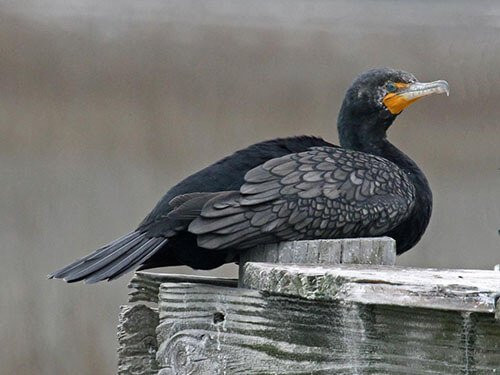 Double-Crested Cormorant habitat
Double-Crested Cormorant habitat
 Double-Crested Cormorant closeup
Double-Crested Cormorant closeup
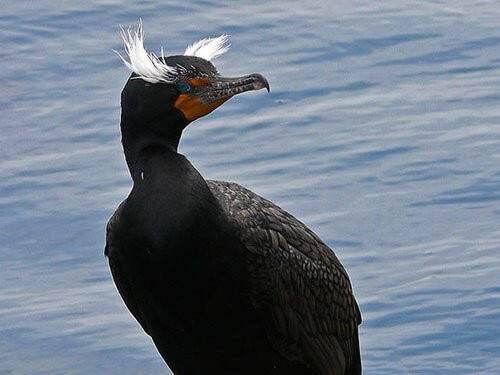 Double-Crested Cormorant eyelashes
Double-Crested Cormorant eyelashes
2.5. Guanay Cormorant, Phalacrocorax bougainvillii
 Guanay Cormorant
Guanay Cormorant
Description: The Guanay Cormorant is a significant producer of guano deposits, hence its name. It has black upperparts, head, and neck, with white underparts. It features red facial skin, a grey bill with some red at the base, and red feet. While similarly colored to the Rock Cormorant, the Guanay Cormorant is larger.
Range: Pacific coast of South America, mainly Chile and Peru.
Habitat: Primarily located off-shore islands.
Diet: Their primary diet is the Peruvian anchoveta, a small and abundant fish.
Conservation status: Near Threatened.
 Guanay Cormorant habitat
Guanay Cormorant habitat
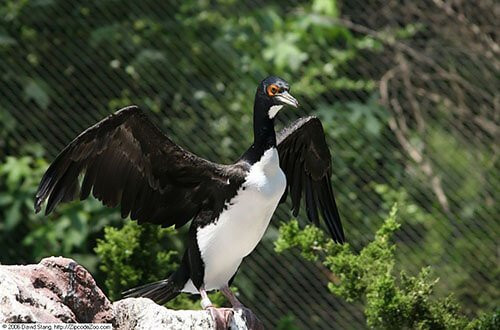 Guanay Cormorant closeup
Guanay Cormorant closeup
2.6. Antarctic Shag, Phalacrocorax bransfieldensis
 Antarctic Shag
Antarctic Shag
Description: The Antarctic Shag, a “blue-eyed shag,” has blue eye-rings. It features black upperparts, including the head, black wings with white wing-bars, a yellow fleshy patch above the bill, a white patch on the back, and pink feet. A crest develops on the head during the breeding season.
Range: Antarctic Peninsula and nearby islands.
Habitat: Marine, inhabiting coasts and islands.
Diet: Their diet consists of fish, crustaceans, octopus, and squid.
Conservation status: Least Concern.
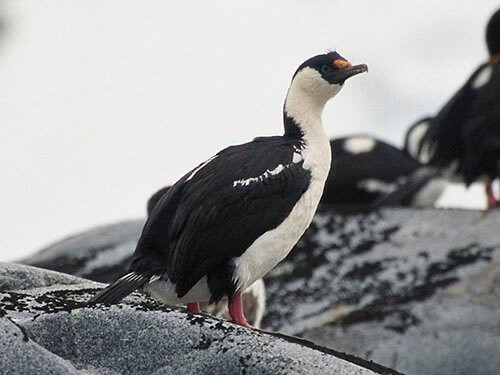 Antarctic Shag habitat
Antarctic Shag habitat
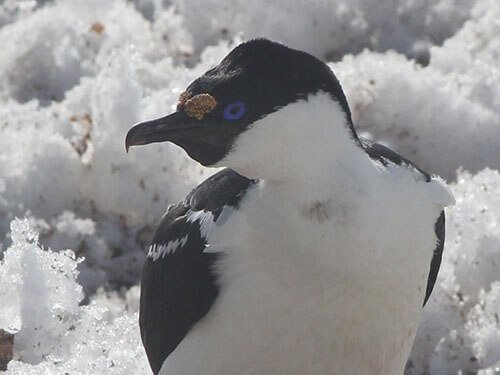 Antarctic Shag closeup
Antarctic Shag closeup
2.7. Neotropic Cormorant, Phalacrocorax brasilianus
 Neotropic Cormorant
Neotropic Cormorant
Description: The Neotropic Cormorant primarily has black plumage and a yellow-brown throat pouch. During the breeding season, white tufts appear on the sides of the head, and the throat patch develops white edges. Juveniles have brownish plumage. Compared to the larger Double-crested Cormorant, the Neotropic Cormorant is small and slender.
Range: From the extreme southern US to the tip of South America, representing a very large range for a cormorant.
Habitat: Coastal and inland waters. Its adaptability to diverse habitats explains its extensive range.
Diet: Their diet includes fish, frogs, and insects.
Conservation status: Least Concern.
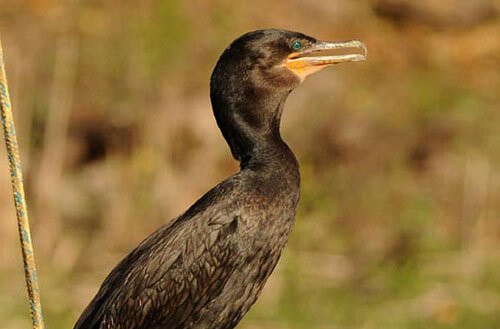 Neotropic Cormorant closeup
Neotropic Cormorant closeup
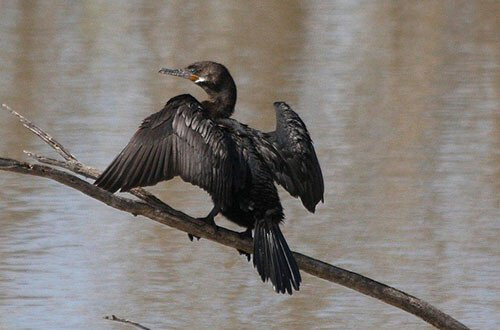 Neotropic Cormorant habitat
Neotropic Cormorant habitat
 Neotropic Cormorant feathering
Neotropic Cormorant feathering
2.8. Campbell Islands Shag, Phalacrocorax campbelli
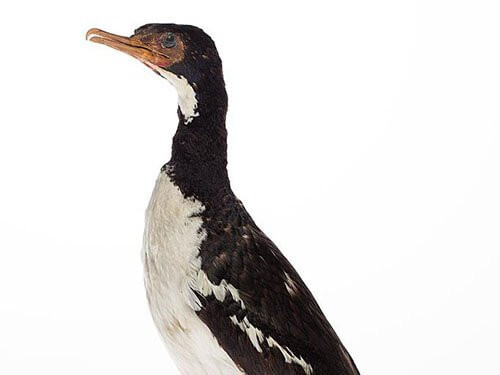 Campbell Islands Shag
Campbell Islands Shag
Description: The Campbell Islands Shag, also called the Campbell Shag, is a “blue-eyed shag.” It has black upperparts, neck, and head, with white underparts. Some individuals have white wing-bars.
Range: Campbell Island, south of New Zealand.
Habitat: It stays within 10 km of Campbell Island and its rocky shores.
Conservation status: Listed as Vulnerable due to breeding only on a single island. However, the population appears healthy, possibly due to the elimination of rats and cats from Campbell Island.
2.9. Cape Cormorant, Phalacrocorax capensis
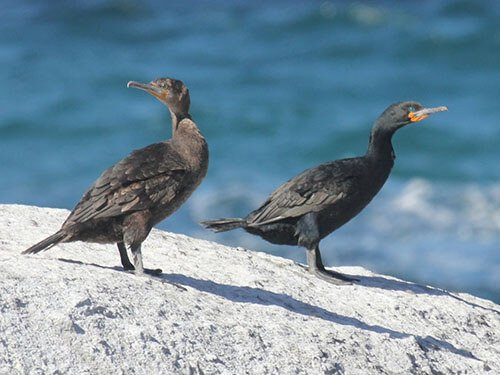 Cape Cormorant
Cape Cormorant
Description: The Cape Cormorant has glossy black plumage with a purplish tinge during the breeding season. It lacks a crest but possesses orange-yellow facial skin. Unusually for cormorants, Cape Cormorants fly in flocks above the water to locate fish before pursuing them underwater.
Range: Coastal Angola, Namibia, and South Africa.
Habitat: Often found in open sea within 10 km of shore.
Diet: Their diet includes fish, crustaceans, and mussels.
Conservation status: Listed as Endangered due to periodic population crashes caused by disease or prey shifts due to environmental changes. While the population may still exceed 100,000 individuals, its future is uncertain.
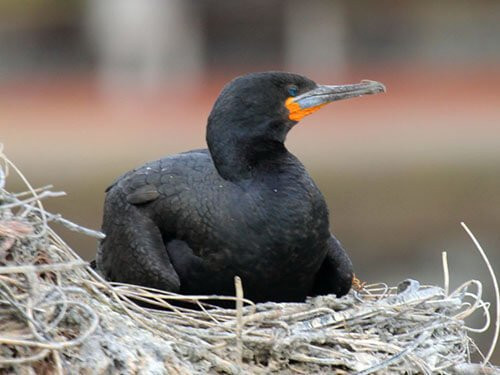 Cape Cormorant habitat
Cape Cormorant habitat
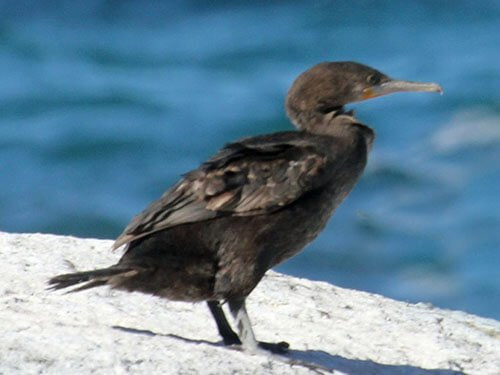 Cape Cormorant closeup
Cape Cormorant closeup
2.10. Japanese Cormorant, Phalacrocorax capillatus
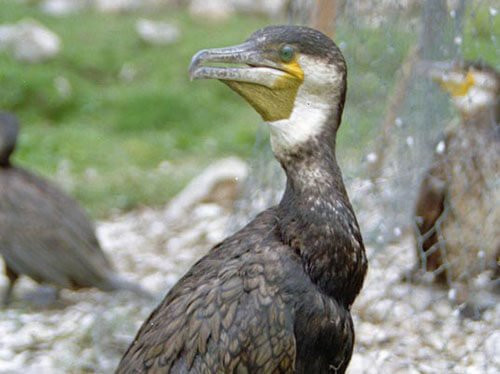 Japanese Cormorant
Japanese Cormorant
Description: The Japanese Cormorant, also known as Temminck’s Cormorant, has been domesticated for centuries by Japanese fishermen. It has a black body, white cheeks and throat, and a white patch on the flanks. The bill is partially yellow. It is very similar to the Great Cormorant, but the Japanese Cormorant has greenish upper-wing coverts, while the Great Cormorant has brownish ones.
Range: Coastal east China and Russia, Korea, Japan, and Taiwan.
Habitat: Located along the coast and adjacent seas, not far inland.
Diet: Primarily fish, caught by pursuit swimming.
Conservation status: Least Concern.
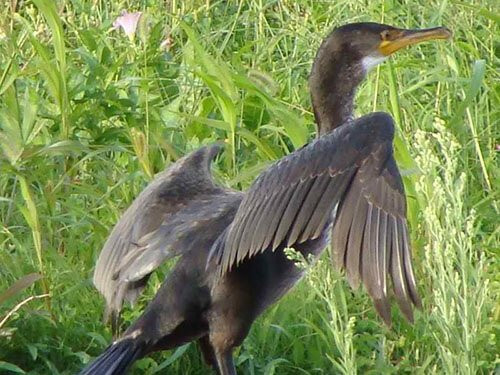 Japanese Cormorant habitat
Japanese Cormorant habitat
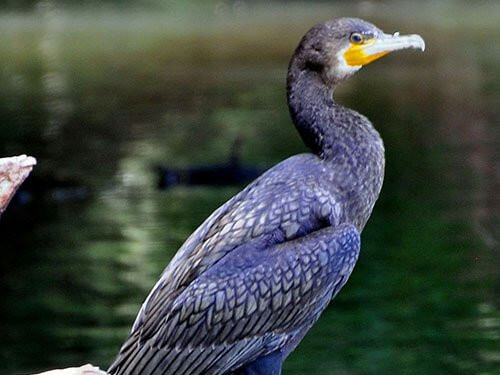 Japanese Cormorant closeup
Japanese Cormorant closeup
2.11. Great Cormorant, Phalacrocorax carbo
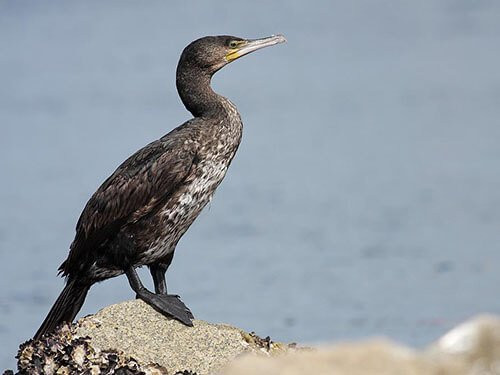 Great Cormorant
Great Cormorant
Description: Except for the White-breasted Cormorant subspecies, the Great Cormorant has mainly black plumage. It features a long tail, a yellow throat patch, and white near its bill. White patches appear on its head during the breeding season. The White-breasted Cormorant (Phalacrocorax c. lucidus) has white extending from its neck to its upper breast.
Range: East coast of North America, Europe, Asia, Africa, Australia, and New Zealand.
Habitat: Found along coasts, freshwater lakes, and ponds.
Diet: Primarily fish, mostly caught near the bottom but also at higher levels. Dives to 6 meters (20 ft) and can stay submerged for up to 30 seconds.
Similar Species:
- European Shag: The Great Cormorant is larger and has a thicker bill.
- Double-Crested Cormorant: The Double-crested Cormorant has more yellow on its throat and bill.
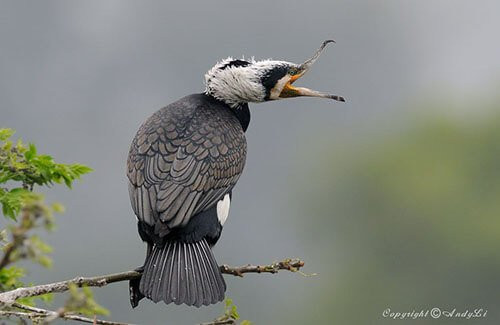 Great Cormorant habitat
Great Cormorant habitat
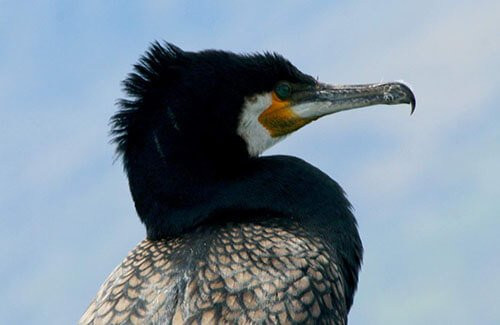 Great Cormorant closeup
Great Cormorant closeup
 Great Cormorant feathering
Great Cormorant feathering
2.12. New Zealand King Shag, Phalacrocorax carunculatus
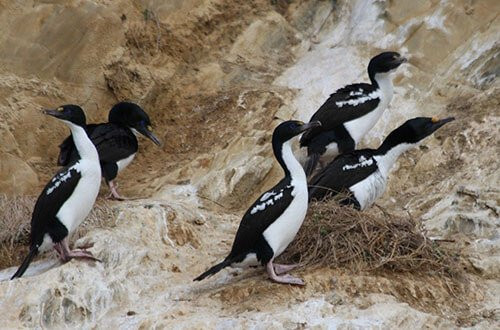 New Zealand King Shag
New Zealand King Shag
Description: The New Zealand King Shag, also known as the Rough-faced Shag or King Shag, has yellow-orange caruncles (wart-like swellings) near its bill, as reflected in its scientific name carunculatus. It has black upperparts, a black tuft on its head, white underparts, and pink feet. Its grey gular pouch turns reddish during the breeding season. A “blue-eyed shag” due to its blue eye-ring.
Range: New Zealand.
Habitat: They hunt in coastal waters and nest on rocky islands.
Diet: Fish and crustaceans.
Conservation status: Classified as Vulnerable due to egg and feather collection. Now protected, and the population has stabilized.
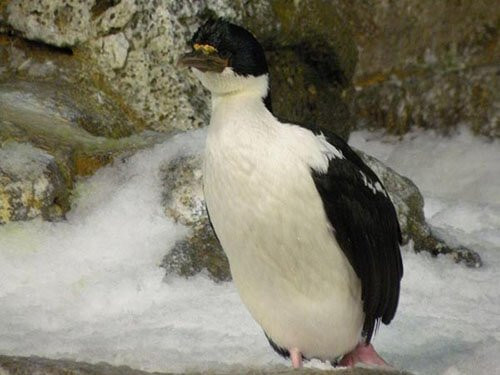 New Zealand King Shag habitat
New Zealand King Shag habitat
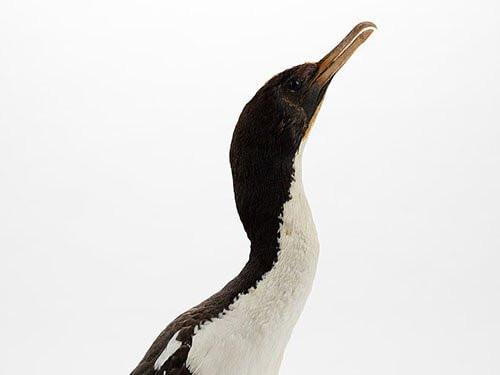 New Zealand King Shag closeup
New Zealand King Shag closeup
2.13. Otago Shag, Phalacrocorax chalconotus
The Foveaux Shag (P. stewarti) and the Otago Shag (P. chalconotus) were previously considered the same species, the Stewart Island Shag.
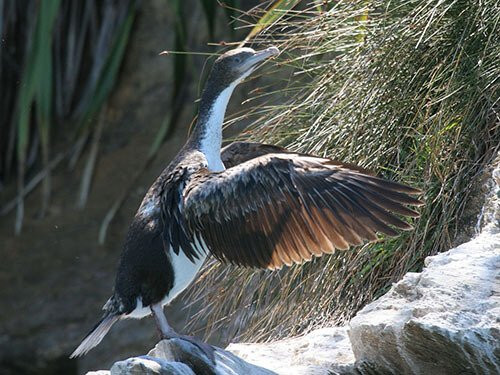 Otago Shag
Otago Shag
Description: The Otago Shag exhibits two morphs: a bronze morph with dark bronze plumage and a pied morph with bronze upperparts, a white wing patch, and white underparts. A “blue-eyed shag” with blue eye-rings. It can be distinguished from the Foveaux Shag by the lack of bright orange caruncles during breeding season, which are present in the Foveaux Shag.
Range: New Zealand, specifically islets off the Otago Peninsula on the eastern coast of the South Island.
Habitat: Forages mainly along the coast, but also up to 10 or more km offshore. Roosts and nests on rocky shores.
Diet: Primarily fish, also crustaceans, squid, and octopus.
Conservation status: The Stewart Island Shag (including Otago and Foveaux Shags) is considered Vulnerable. Once plentiful, populations declined after human settlement in New Zealand. The current population of Otago Shags is estimated at around 5000 and may be decreasing.
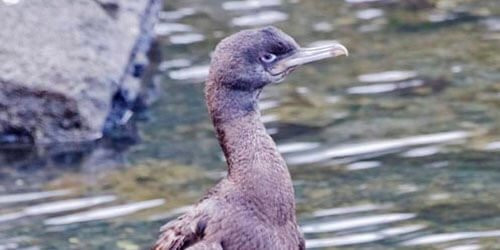 Otago Shag closeup
Otago Shag closeup
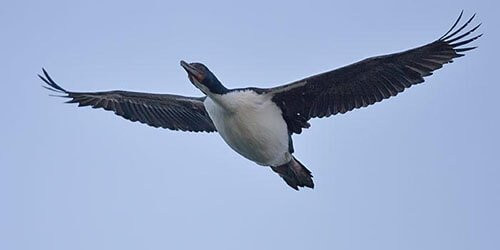 Otago Shag in flight
Otago Shag in flight
2.14. Auckland Islands Shag, Phalacrocorax colensoi
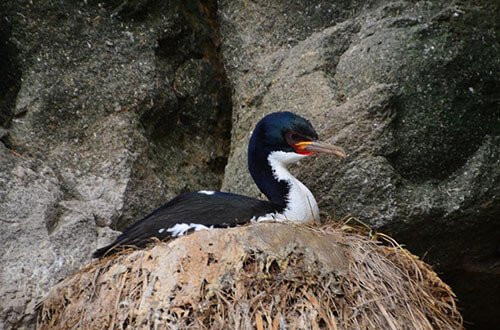 Auckland Islands Shag
Auckland Islands Shag
Description: The Auckland Islands Shag has black upperparts, sometimes with a white wing-bar, white underparts, and a white throat. A “blue-eyed shag” with blue eye-rings.
Range: Auckland Islands, south of New Zealand.
Habitat: At sea or along the coast. Nests in rocky areas and also on flat ground.
Diet: Crustaceans and fish.
Conservation status: Considered Vulnerable due to a small population of less than 2000 birds and limited geographical diversity.
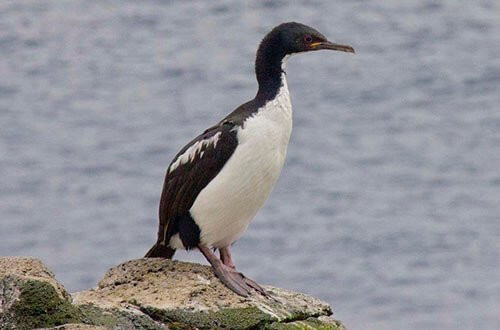 Auckland Islands Shag habitat
Auckland Islands Shag habitat
2.15. Pitt Island Shag, Phalacrocorax featherstoni
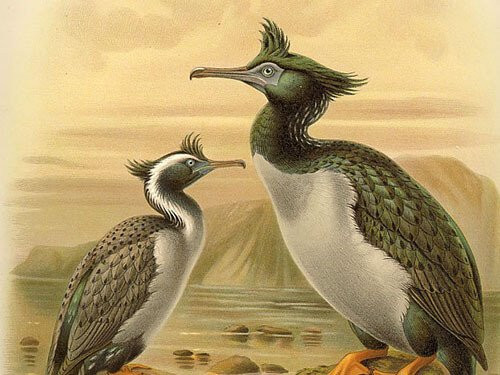 Pitt Island Shag
Pitt Island Shag
Description: During breeding season, the Pitt Island Shag has black with bluish-gloss upperparts and neck, green facial skin, and two black crests on its head. Outside of breeding season, the upperparts become dull brown, facial skin dull yellow, and crests become less prominent or disappear. Underparts are white, and feet are yellow.
Range: Chatham Islands of New Zealand.
Habitat: Sea and coasts for foraging, rocky shores for roosting and breeding.
Diet: Primarily fish, also crustaceans.
Conservation status: Endangered due to a small population size of less than 1500. The population appears to be declining, possibly due to environmental changes affecting prey availability.
2.16. Black-Faced Cormorant, Phalacrocorax fuscescens
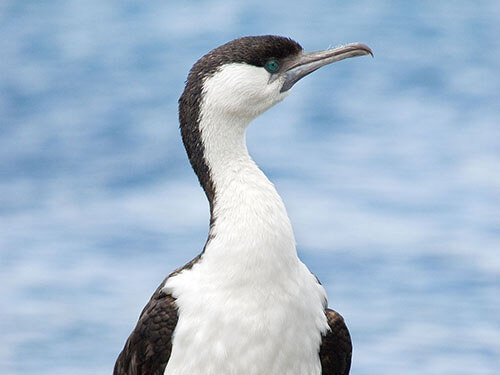 Black-Faced Cormorant
Black-Faced Cormorant
Description: The Black-faced Cormorant has black upperparts, bill, and facial skin. Its black cap extends below its eyes, giving it its name. Underparts are white. It can be differentiated from similar Little Pied Cormorants and Pied Cormorants by the black extending below the eyes. Juveniles have brownish-black upperparts with a brownish-white face and neck.
Range: Southern Australia.
Habitat: Mainly coastal and marine, also river estuaries.
Diet: Primarily fish, also squid and octopus.
Conservation status: Least Concern.
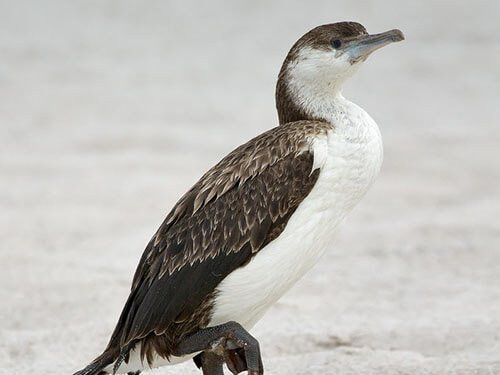 Black-Faced Cormorant closeup
Black-Faced Cormorant closeup
 Black-Faced Cormorant habitat
Black-Faced Cormorant habitat
2.17. Indian Cormorant, Phalacrocorax fuscicollis
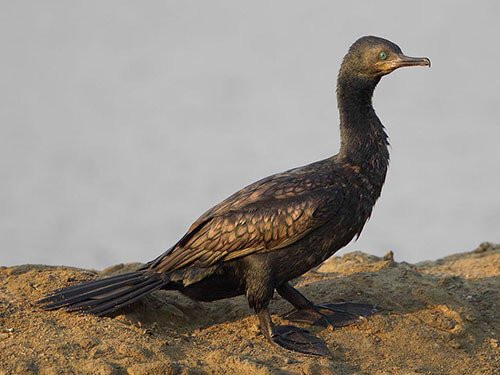 Indian Cormorant
Indian Cormorant
Description: The Indian Cormorant has a generally dark appearance with bronzed wings. It features blue eyes, a small and slightly peaked head, and a long, narrow bill ending in a hook. Plumage becomes glossy black during breeding season, contrasting with brownish-black at other times. The similar Little Cormorant is slightly smaller with a considerably smaller bill.
Range: Southern Asia.
Habitat: River inlets, mangroves, and estuaries, avoiding the open coast.
Diet: Mainly fish.
Conservation status: Least Concern.
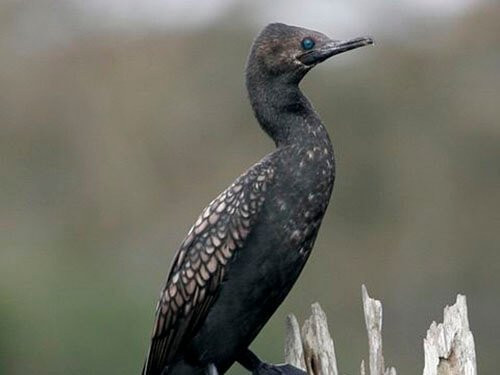 Indian Cormorant closeup
Indian Cormorant closeup
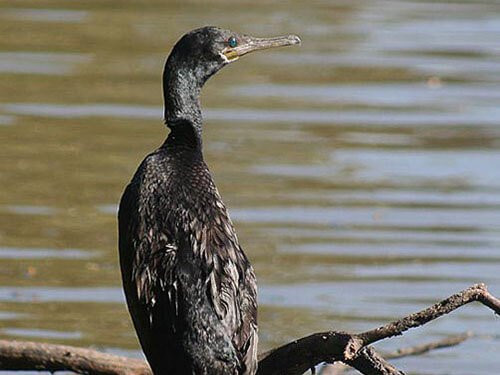 Indian Cormorant habitat
Indian Cormorant habitat
2.18. Red-Legged Cormorant, Phalacrocorax gaimardi
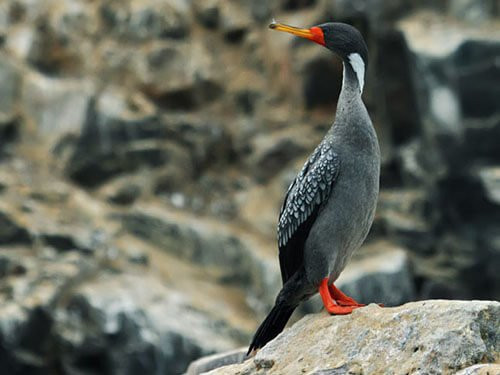 Red-Legged Cormorant
Red-Legged Cormorant
Description: As expected, the Red-legged Cormorant has bright red legs and feet. Its plumage is mainly grey with white spots on the wings and a white patch on the neck. Tail is black, eyes are green, and the bill is yellow.
Range: South America, mainly on the west coast.
Habitat: Near the shore and relatively close to its nest, avoiding freshwater.
Diet: Fish, especially anchovies, and eels.
Conservation status: Considered Near Threatened because, despite its wide range, its population density is low and likely decreasing.
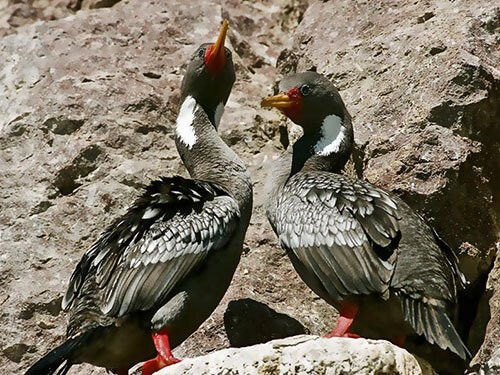 Red-Legged Cormorant habitat
Red-Legged Cormorant habitat
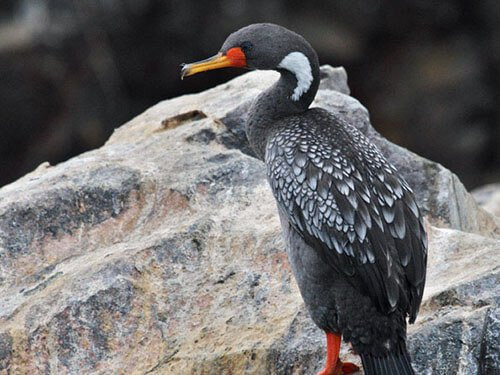 Red-Legged Cormorant closeup
Red-Legged Cormorant closeup
2.19. South Georgia Shag, Phalacrocorax georgianus
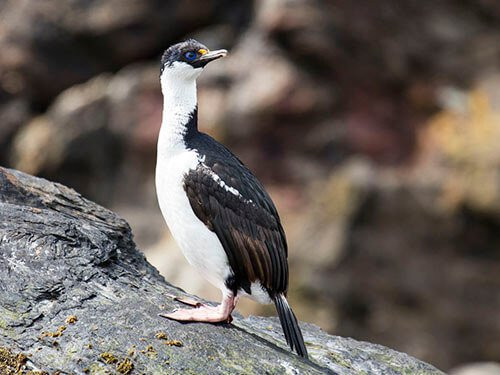 South Georgia Shag
South Georgia Shag
Description: The South Georgia Shag has black upperparts, including the nape, a white wing-bar, and white underparts, including the underside of its neck. During breeding season, it develops an erectile crest and orange warty flesh (caruncle) above the bill base. A “blue-eyed shag” with blue eye-rings.
Range: Islands between South America and Antarctica, specifically South Georgia, South Sandwich Islands, and South Orkney Islands.
Habitat: Marine and inshore.
Conservation status: Not globally threatened.
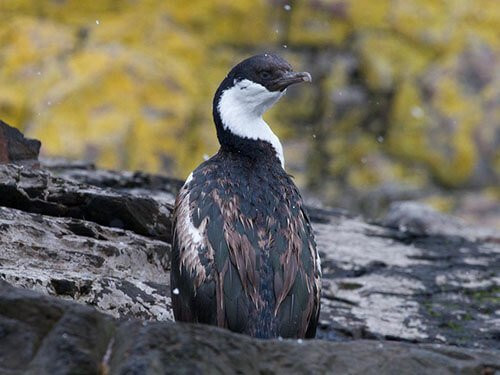 South Georgia Shag habitat
South Georgia Shag habitat
 South Georgia Shag closeup
South Georgia Shag closeup
2.20. Flightless Cormorant, Phalacrocorax harrisi
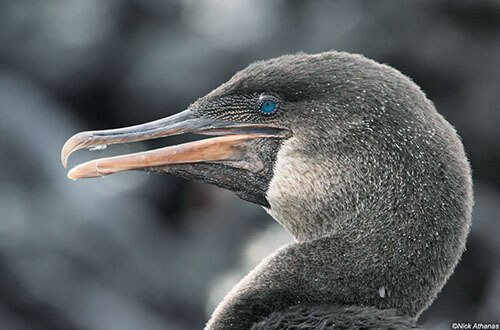 Flightless Cormorant
Flightless Cormorant
Description: The Flightless Cormorant is the only cormorant species unable to fly. Its wings are approximately one-third the size needed for flight. It has blackish upperparts, brown underparts, and turquoise eyes.
Range: Galapagos Islands.
Habitat: No more than 200 meters offshore. Nests on rocky shores.
Diet: Fish, octopus, squid, and eels.
Conservation status: Listed as Vulnerable. Flightlessness evolved due to the absence of natural predators. However, introduced predators like dogs and cats, along with humans, pose a threat. The population appears stable at around 1000 individuals.
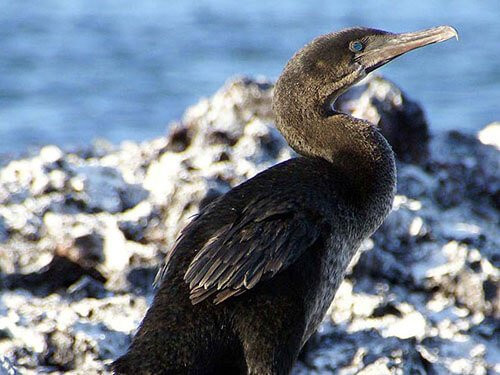 Flightless Cormorant closeup
Flightless Cormorant closeup
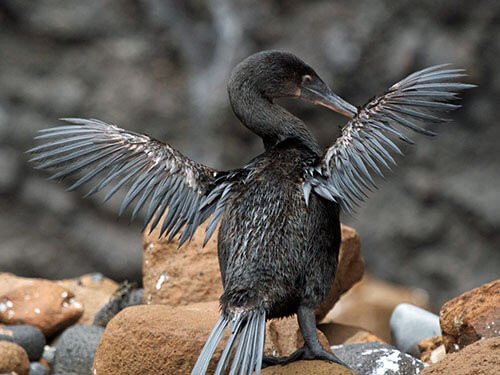 Flightless Cormorant habitat
Flightless Cormorant habitat
2.21. Magellan Cormorant, Phalacrocorax magellanicus
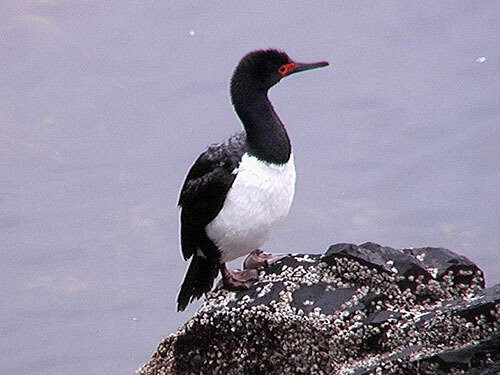 Magellan Cormorant
Magellan Cormorant
Description: The Magellanic Cormorant, also known as the Rock Shag, has black upperparts, head, and neck, white underparts, red facial skin, and pinkish legs. During breeding season, it develops a small blackish crest and a white ear patch.
Range: South America (Patagonia, Argentina).
Habitat: Forages close to shore, diving to depths of no more than 10 meters. Nests on steep rocky cliffs.
Diet: Marine worms, fish, octopus, and squid.
Conservation status: Least Concern.
Similar Species:
- Imperial Shag: The Imperial Shag has white on its foreneck, while the Rock Shag has an entirely black neck.
- Guanay Cormorant: The Guanay Cormorant is larger.
 Magellan Cormorant habitat
Magellan Cormorant habitat
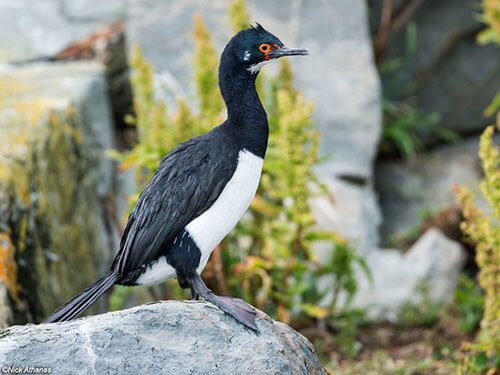 Magellan Cormorant closeup
Magellan Cormorant closeup
2.22. Bank Cormorant, Phalacrocorax neglectus
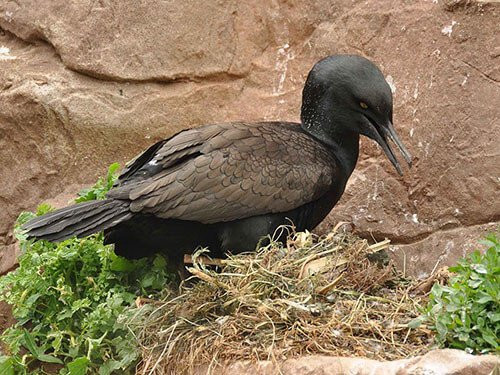 Bank Cormorant
Bank Cormorant
Description: The Bank Cormorant, also known as Wahlberg’s Cormorant, has mainly black plumage with dark brown wings. It is glossy with a bronze sheen, and features a blackish bill, black legs, and yellow eyes.
Range: African west coast (Namibia and South Africa).
Habitat: Coastal and up to 10 km offshore, preferring kelp beds that shelter lobster. Primarily breeds on islands and rocky shores.
Diet: Fish, crustaceans, squid, octopus, and mollusks.
Conservation status: Endangered, with a declining population due to fishing reducing prey availability and increased predation by kelp gulls on eggs and chicks. Approximately 1000 birds remain.
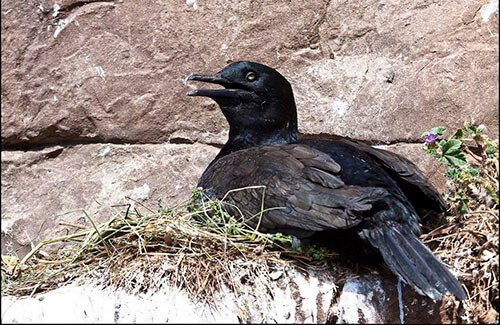 Bank Cormorant closeup
Bank Cormorant closeup
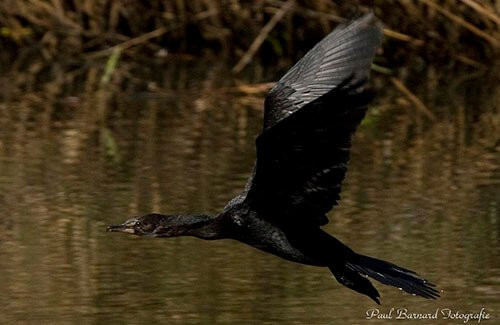 Bank Cormorant in flight
Bank Cormorant in flight
2.23. Socotra Cormorant, Phalacrocorax nigrogularis
 Socotra Cormorant
Socotra Cormorant
Description: The Socotra Cormorant has blackish plumage and blackish legs. During breeding season, it displays greyish-green tinged upperparts and a glossy purple-tinged forecrown.
Range: Persian Gulf of Asia.
Habitat: Primarily a marine bird, nesting on isolated islands.
Diet: Mainly fish.
Conservation status: Listed as Vulnerable, despite an estimated population of over a quarter million birds. Concerns exist due to coastal development and pollution near breeding sites.
2.24. Heard Island Shag, Phalacrocorax nivalis
Description: The Heard Island Shag has mainly black upperparts with wide white wing-bars, white underparts, white cheeks and ear-coverts, a dark bill, and pink feet. During breeding season, it develops a crest and orange fleshy patches (caruncles) above the bill base. A “blue-eyed shag” with blue eye-rings, typically exhibiting more white on its upperparts than other shags in its range.
Range: Heard and McDonald Islands, Antarctic islands southwest of Perth, Australia.
Habitat: Prefers shallow coastal waters around their islands for hunting. Roosts and nests mainly on cliffs, but also on beaches.
Conservation status: Vulnerable due to a small population of around 1000. Increased commercial fishing could pose a threat.
2.25. Chatham Islands Shag, Phalacrocorax onslowi
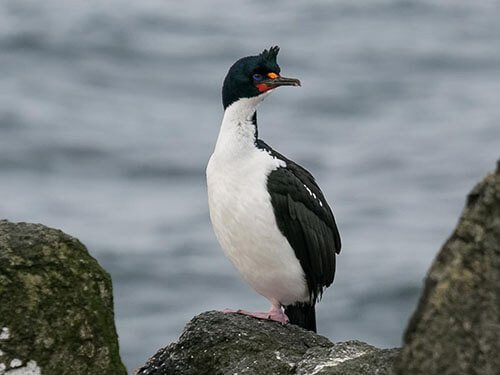 Chatham Islands Shag
Chatham Islands Shag
Description: The Chatham Islands Shag has black upperparts, including its head, white underparts, a dark grey bill, and dull pink legs. A “blue-eyed shag” with blue eye-rings.
Range: Chatham Islands of New Zealand.
Habitat: Breeds along the coast and hunts within a few km of shore in sheltered areas.
Conservation status: Critically Endangered due to human disturbance at nesting areas and introduced predators like feral cats.
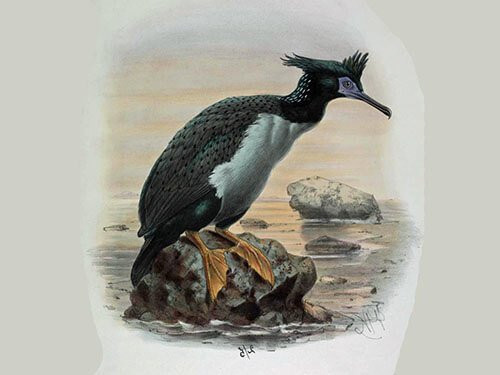 Chatham Islands Shag drawing
Chatham Islands Shag drawing
2.26. Pelagic Cormorant, Phalacrocorax pelagicus
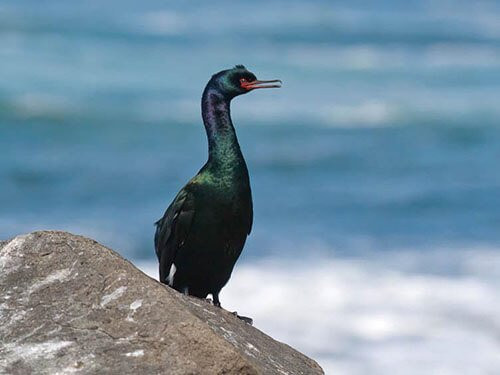 Pelagic Cormorant
Pelagic Cormorant
Description: The Pelagic Cormorant has iridescent black plumage, black feet, a long, thin black bill, and green eyes. During breeding season, it develops white flanks and one or two short black crests on its head. The patch of dark naked skin below the eyes turns red.
Range: Pacific Coast of North America and Asia.
Habitat: Sheltered bays and inlets, but also far out to sea. Nests on rocky coasts.
Diet: Mainly fish, also crustaceans.
Conservation status: Least Concern.
Similar Species:
- Brandt’s Cormorant: Brandt’s Cormorant has a white cheek and a blue throat in breeding season.
- Double-Crested Cormorant: The Pelagic Cormorant is smaller and more slender and has red facial skin when breeding.
- Red-Faced Cormorant: Breeding Red-faced Cormorants have extensive red on their face, while breeding Pelagic Cormorants have red only below their eyes. Nonbreeding Red-faced Cormorants retain some red on their face, unlike Pelagic Cormorants.
 Pelagic Cormorant closeup
Pelagic Cormorant closeup
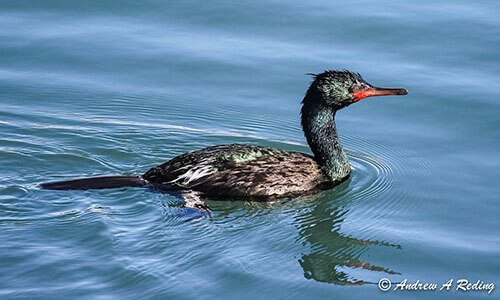 Pelagic Cormorant habitat
Pelagic Cormorant habitat
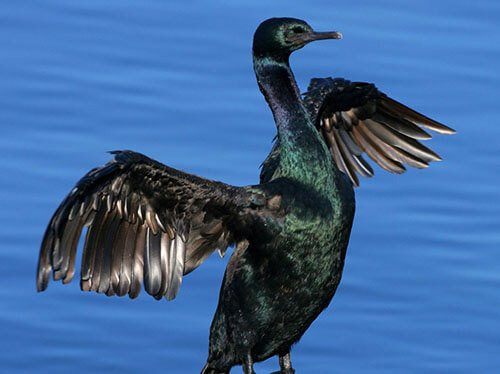 Pelagic Cormorant feathering
Pelagic Cormorant feathering
2.27. Brandt’s Cormorant, Phalacrocorax penicillatus
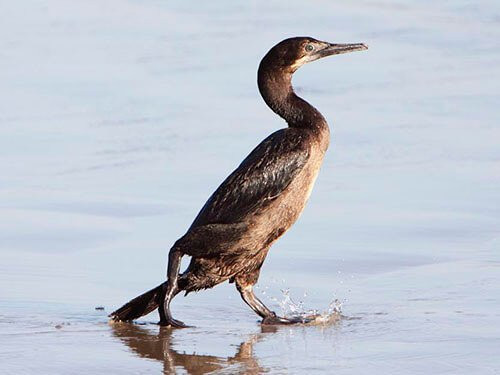 Brandt’s Cormorant
Brandt’s Cormorant
Description: Brandt’s Cormorant has mainly black plumage but features a white cheek patch. During breeding season, it develops white plumes on the neck and back, along with a blue throat patch. It can be distinguished from the similar Pelagic Cormorant by its white cheek and blue throat patch in breeding season.
Range: Pacific coast of North America.
Habitat: Coastal environments such as estuaries and lagoons. Dives to 60 meters (200 ft).
Diet: Herring, rockfish, and other readily available fish, as well as shrimp and crabs.
Conservation status: Least Concern.
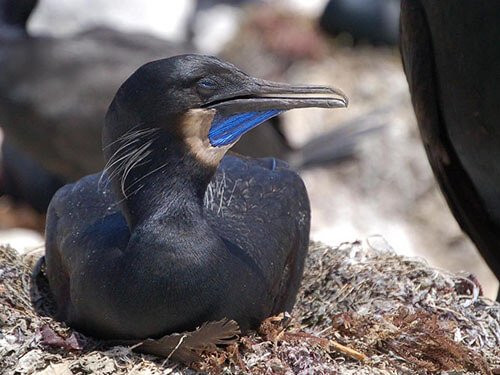 Brandt’s Cormorant habitat
Brandt’s Cormorant habitat
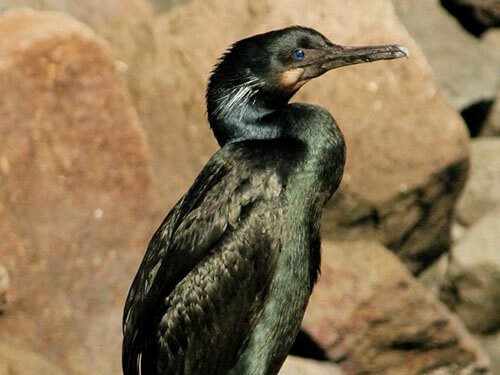 Brandt’s Cormorant closeup
Brandt’s Cormorant closeup
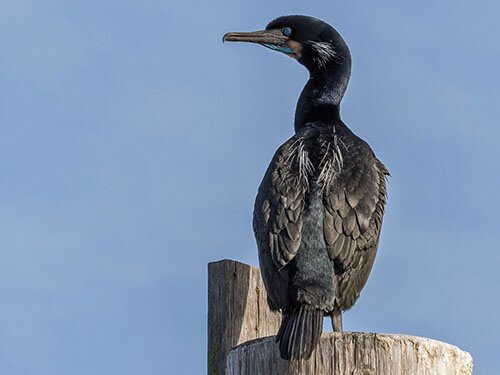 Brandt’s Cormorant feathering
Brandt’s Cormorant feathering
2.28. Spotted Shag, Phalacrocorax punctatus
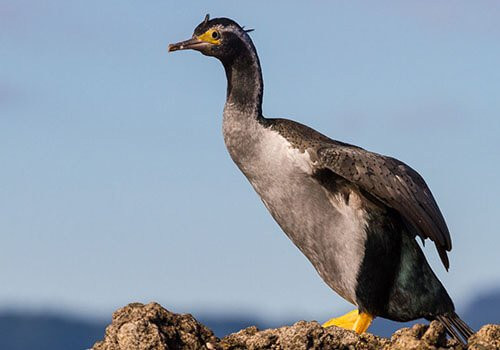 Spotted Shag
Spotted Shag
Description: The Spotted Shag has brown upperparts with small dark spots, mainly white underparts, and a black lower belly. The sides of the neck and face are white, while the crown and throat are blue-green. Leg color varies from bright yellow to dull yellowish-brown. A black crest develops during mating season.
Range: New Zealand, mainly the South Island.
Habitat: Coastal and offshore up to 15 km, avoiding freshwater. Nests on rocky shores and cliffs.
Conservation status: Least Concern.
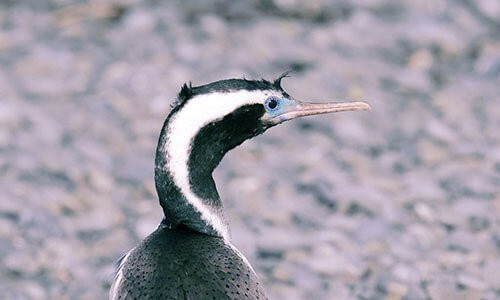 Spotted Shag closeup
Spotted Shag closeup
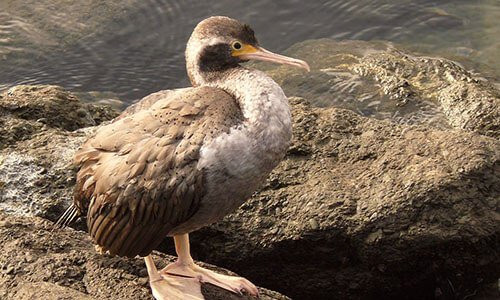 Spotted Shag habitat
Spotted Shag habitat
2.29. Macquarie Shag, Phalacrocorax purpurascens
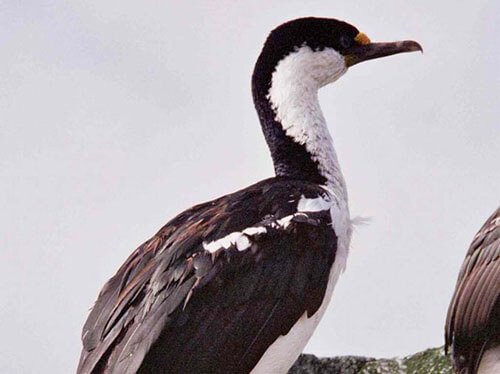 Macquarie Shag
Macquarie Shag
Description: The Macquarie Shag, named after Macquarie Island, has mainly black upperparts, including the crown and nape, white wing-bars, white underparts, foreneck, and face. Orange fleshy growths (caruncles) appear above the bill base during breeding season. A “blue-eyed shag” with blue eye-rings.
Range: Macquarie Island and nearby islets, between New Zealand and Antarctica.
Habitat: Marine bird that breeds and roosts on islands.
Diet: Fish, crustaceans, and octopus.
Conservation status: Vulnerable due to a small population of less than 1000 living in a localized region. Severe weather, food shortages, and introduced rats pose threats.
2.30. Bounty Islands Shag, Phalacrocorax ranfurlyi
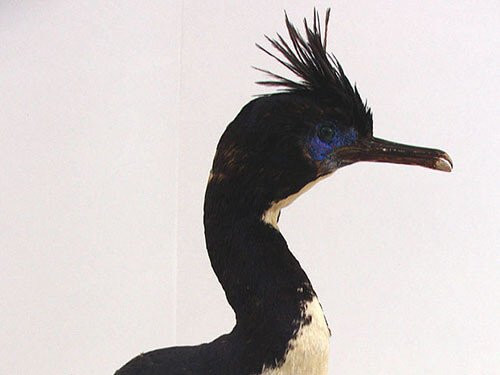 Bounty Islands Shag
Bounty Islands Shag
Description: The Bounty Islands Shag, also known as the Bounty Shag, has black upperparts and nape with a blue metallic sheen, white underparts, and a white patch on the wings forming a wing-bar when folded. Feet are pink. A “blue-eyed shag” with blue eye-rings.
Range: Bounty Islands, southeast of New Zealand.
Habitat: Open seas and rocky shores.
Diet: Fish, crustaceans, octopus, and squid.
Conservation status: Considered Vulnerable due to a small population of less than 1000 and a limited breeding range. The population appears stable.
2.31. Foveaux Shag, Phalacrocorax stewarti
The Foveaux Shag (P. stewarti) and the Otago Shag (P. chalconotus) were previously considered the same species, the Stewart Island Shag.
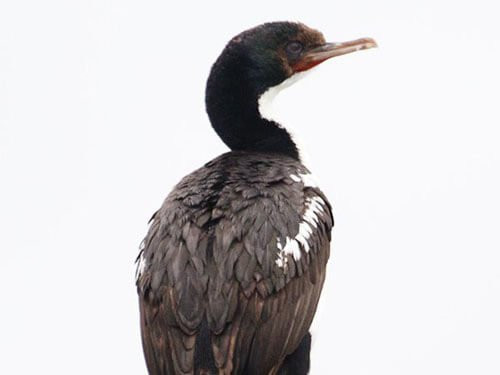 Foveaux Shag
Foveaux Shag
Description: The Foveaux Shag exhibits two morphs: a bronze morph with dark bronze plumage and a pied morph with bronze upperparts, a white wing patch, and white underparts. A “blue-eyed shag” with blue eye-rings. Distinguished from the Otago Shag by the presence of bright orange caruncles during breeding season.
Range: New Zealand, specifically Stewart Island and Foveaux Strait.
Habitat: Forages mainly along the coast but also up to 10 or more km offshore. Roosts and nests on rocky shores.
Diet: Primarily fish, also crustaceans, squid, and octopus.
Conservation status: The Stewart Island Shag (including Foveaux and Otago Shags) is considered Vulnerable. Once plentiful, populations declined after human settlement in New Zealand. The Foveaux Shag population is estimated at around 2500 and may be declining.
 Foveaux Shag habitat
Foveaux Shag habitat
2.32. Little Black Cormorant, Phalacrocorax sulcirostris
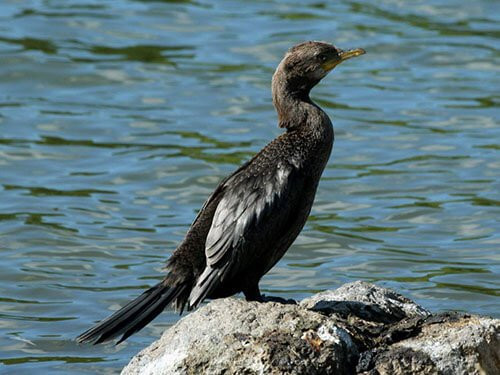 Little Black Cormorant
Little Black Cormorant
Description: The Little Black Cormorant has black plumage, black legs, a long and slender grey bill, and blue-green eyes. Juveniles have brown and black plumage and brown eyes. Non-breeding plumage is more brownish.
Range: Australia and northern New Zealand.
Habitat: Mainly freshwater, occasionally coastal.
Diet: Primarily fish.
Conservation status: Least Concern.
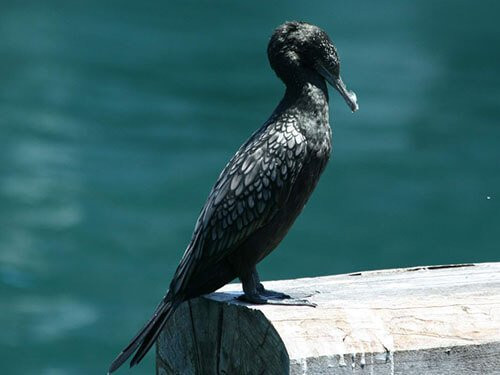 Little Black Cormorant habitat
Little Black Cormorant habitat
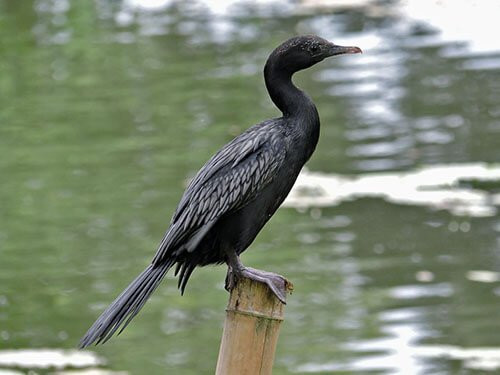 Little Black Cormorant closeup
Little Black Cormorant closeup
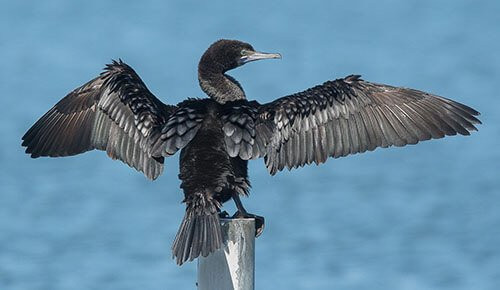 Little Black Cormorant feathering
Little Black Cormorant feathering
2.33. Red-Faced Cormorant, Phalacrocorax urile
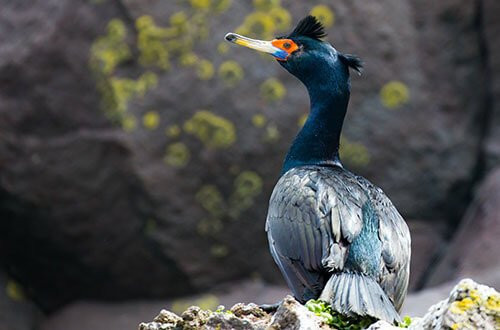 Red-Faced Cormorant
Red-Faced Cormorant
Description: The Red-faced Cormorant has glossy black plumage with greenish-blue iridescence. During breeding season, it develops orange or red facial skin and a double crest. Non-breeding plumage retains slightly visible orange/red facial skin.
Range: Asia and the Alaskan coast.
Habitat: Almost exclusively marine, venturing a few meters onshore to roost and nest.
Similar Species: Pelagic Cormorant. Their ranges overlap, and they often share breeding grounds. Breeding Red-faced Cormorants have extensive red facial skin, while breeding Pelagic Cormorants have red only below the eyes. Nonbreeding Red-faced Cormorants retain some red, unlike Pelagic Cormorants.
Conservation status: Least Concern.
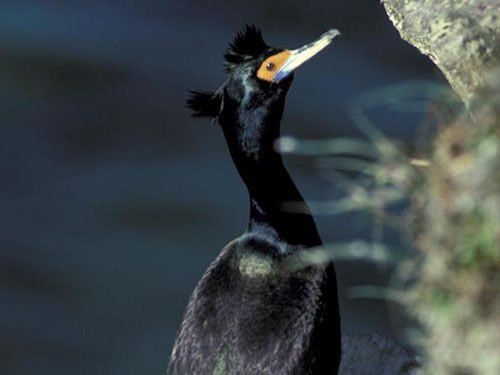 Red-Faced Cormorant closeup
Red-Faced Cormorant closeup
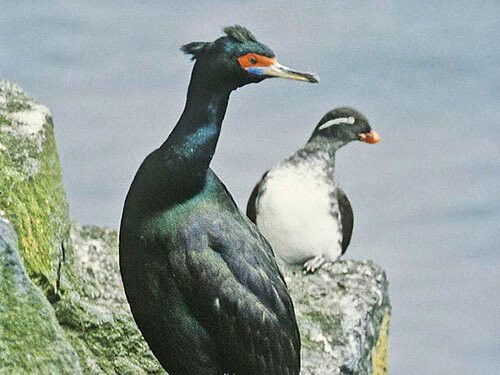 Red-Faced Cormorant habitat
Red-Faced Cormorant habitat
2.34. Pied Cormorant, Phalacrocorax varius
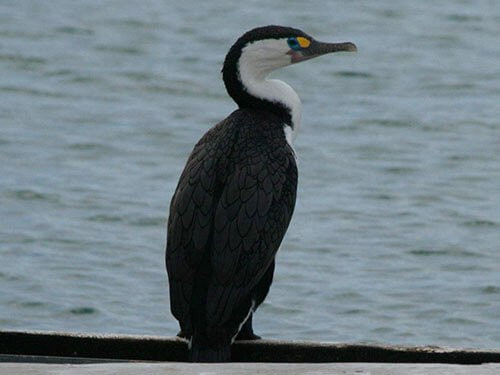 Pied Cormorant
Pied Cormorant
Description: The Pied Cormorant, also known as the Australian Pied Cormorant, has black upperparts, legs, and feet. The black on the head remains above the eyes, with white below. Underparts are white, and lores are orange.
Range: Australia and New Zealand.
Habitat: Mainly marine, also ponds and lakes. Forages typically less than 10 meters deep (30 ft).
Diet: Primarily fish, also crustaceans, octopus, and squid.
Conservation status: Least Concern.
Similar Species:
- Black-faced Cormorant: The Black-faced Cormorant’s black cap covers the eyes, while the Pied Cormorant has white above the eyes.
- Little Pied Cormorant: The Pied Cormorant is much larger and has a proportionally longer bill.
- Rough-Faced Shag: The Pied Cormorant has black feet, while the Rough-faced Shag has pink feet.
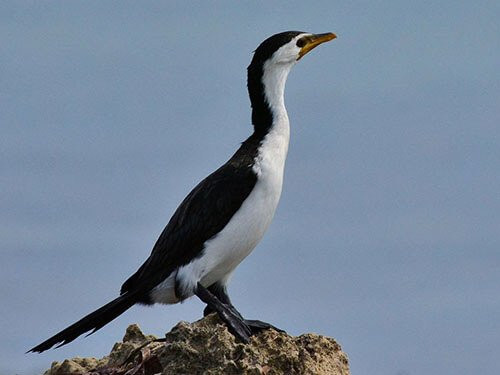 Pied Cormorant closeup
Pied Cormorant closeup
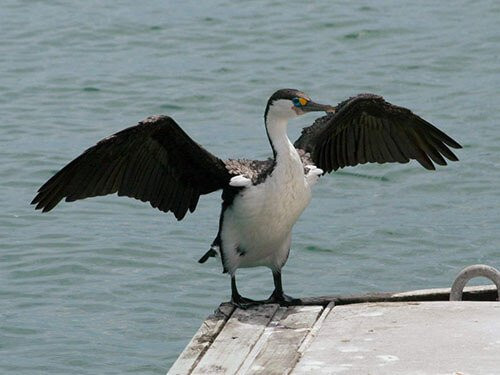 Pied Cormorant habitat
Pied Cormorant habitat
2.35. Kerguelen Shag, Phalacrocorax verrucosus
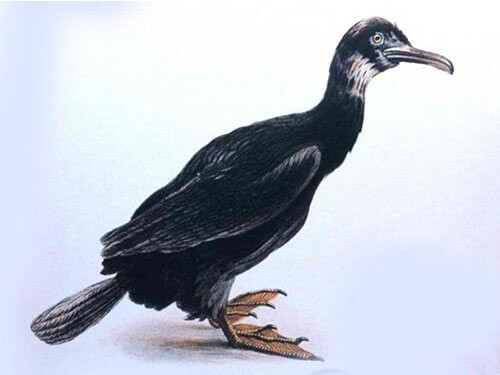 Kerguelen Shag
Kerguelen Shag
Description: The Kerguelen Shag has black upperparts, tail, and thighs, blackish facial skin, and a dark blue forehead. Some have white patches on the wings and back. Underparts and throat are white. Orange fleshy bumps (caruncles) are present above the bill base. Breeding plumage is brighter with a small erectile crest. A “blue-eyed shag” with dull blue eye-rings, and the smallest blue-eyed shag species. Juveniles are mainly dark brown, lack caruncles, and have brown feet.
Range: Kerguelen Islands in the southern Indian Ocean.
Habitat: Forages at sea, usually within 6 km (4 mi) of shore.
Diet: Fish, crustaceans, and worms. Hunts alone in summer, in large groups otherwise.
Similar Species: Heard Island Shag range rarely overlaps. The Heard Island Shag has white cheeks, while the Kerguelen Shag does not.
Conservation status: Least Concern.
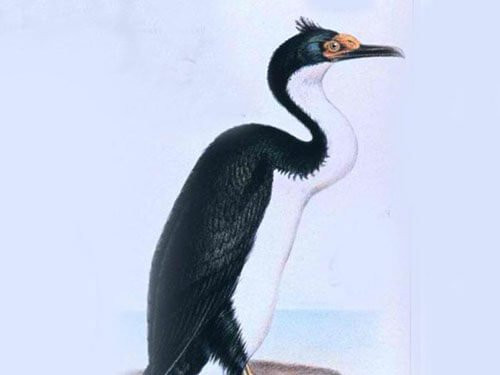 Kerguelen Shag closeup
Kerguelen Shag closeup
Conclusion: Conservation Concerns within the Cormorant Family
While most cormorant populations are currently stable, a significant number of species are classified as vulnerable or endangered. The Chatham Shag, endemic to the Chatham Islands of New Zealand, is critically endangered due to human-induced disturbances at breeding colonies and introduced predators like wekas, possums, and feral cats.
Several other New Zealand species also face conservation risks, including the Otago Shag, New Zealand King Shag, Campbell Shag, Auckland Shag, and the endangered Pitt Shag.
Other vulnerable island species include the Socotra Cormorant, Macquarie Shag, and Bounty Shag. The Bank Cormorant, endemic to southwestern Africa, is also endangered.
A common thread among these threatened species is their limited geographic distribution, often breeding on single islands. Island endemism, while fostering unique evolutionary paths, also creates vulnerabilities. Isolated species, perfectly adapted to their specific environment, can struggle when faced with rapid environmental changes, introduced predators, or habitat degradation.
As human activities drive global change, these specialized species face increasing threats. Conservation efforts are crucial to mitigate harm and potentially relocate threatened species to more secure locations. However, introducing species to new environments carries its own risks, including the potential for invasive species dynamics. The future of these unique members of the cormorant family hinges on proactive conservation strategies and a deeper understanding of the delicate balance within island ecosystems.
